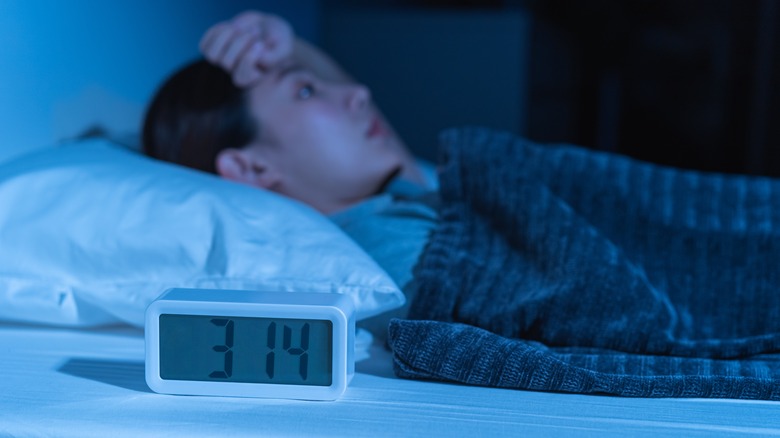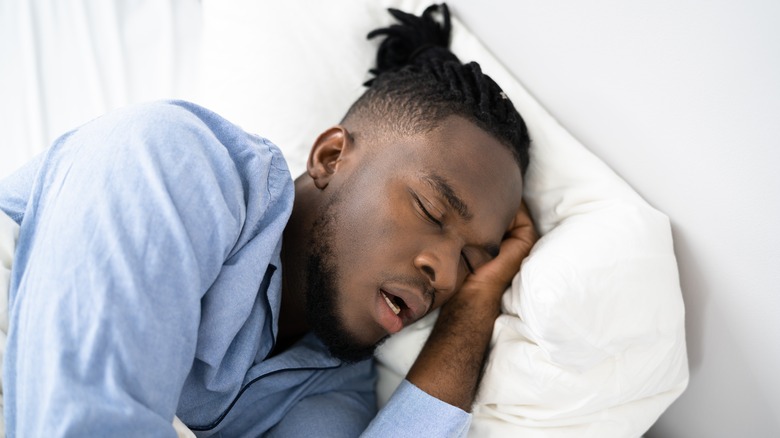Warning Signs Your Insomnia Is Actually Sleep Apnea
Sleep disorders are tricky enough to diagnose on their own, but it's even more challenging when two different sleep disorders present with similar symptoms. In some cases, what looks like insomnia on the surface may actually be warning signs of sleep apnea. Let's break down the what's what of each condition.
Both insomnia and sleep apnea fall under the category of sleep-wake disorders, according to the American Psychiatric Association. With symptoms reported to affect approximately one-third of adults, insomnia can make attempts at getting a good night's rest, well, a nightmare. Also affecting quality of sleep, sleep apnea is a disorder in which one's breathing is repeatedly interrupted during sleep, usually resulting in gasping or snoring sounds. Although there are two types of sleep apnea, most people experience obstructive sleep apnea (OSA). According to the National Heart, Lung, and Blood Institute, OSA occurs when the airways become blocked, whether from large tonsils, the tongue relaxing into the back of the throat, or certain health conditions, among other possible causes. They sound different enough, but insomnia and sleep apnea do share a few things in common.
Similarities and differences between insomnia and sleep apnea
As outlined in a 2019 research article published in Brain Sciences, there is such a thing as joint insomnia and sleep apnea — aptly named comorbid insomnia and sleep apnea (COMISA). With prevalence rates standing at approximately 30% to 50%, people with the disorder often experience fatigue, daytime sleepiness, poor quality of sleep, and more. With sleep apnea and insomnia each sharing these symptoms, how can we differentiate between the two?
While both disorders can leave us staring up at the ceiling as the minutes tick by, taking note of what point during the night you find yourself lying awake may give you a clue as to whether you're dealing with sleep apnea rather than insomnia. Insomnia is often characterized by difficulty initiating sleep, while sleep apnea is more closely correlated with wake-ups in the middle of the night. Therefore, if you're still wide awake long after you've climbed into bed, the culprit is likely insomnia. On the other hand, if you're someone who falls asleep rather quickly (a study published in the 2015 textbook "Sleep Medicine Pearls" notes that people with obstructive sleep apnea tend to fall asleep within six to seven minutes), but you're lying awake at night because you've been roused from sleep, it may be a sign that you're instead dealing with sleep apnea. Another potential warning sign is if you share a bedroom with another person, and they mention that you tend to be a loud snorer.
Diagnosis and treatment of insomnia and sleep apnea
Although this method may give you an inkling as to which sleep disorder you might be experiencing, taking note of whether you're lying awake at the start of the night or in the middle of the night is not a guaranteed measure by which to self-diagnose insomnia versus sleep apnea. After all, as the National Heart, Lung, and Blood Institute points out, frequent wake-ups can sometimes be a sign of insomnia too, particularly in older adults. For this reason, it's best to leave a formal diagnosis in the hands of a specialist if sleep disturbances are affecting your day-to-day life. You don't want to leave sleep disorders untreated, as a lack of quality sleep may make a person more susceptible to hypertension, high cholesterol, cancer, or heart attack, according to Medical News Today.
Treatment may vary depending on which condition a patient is diagnosed with. A sleep diary, questionnaires, or sleep tracking data may be used as diagnostic tools. In some cases, a sleep study may also be suggested, particularly in suspected cases of sleep apnea or COMISA. Treatment may involve the use of a continuous positive airway pressure (CPAP) machine, mental health counseling, or lifestyle changes to support healthy sleep.


